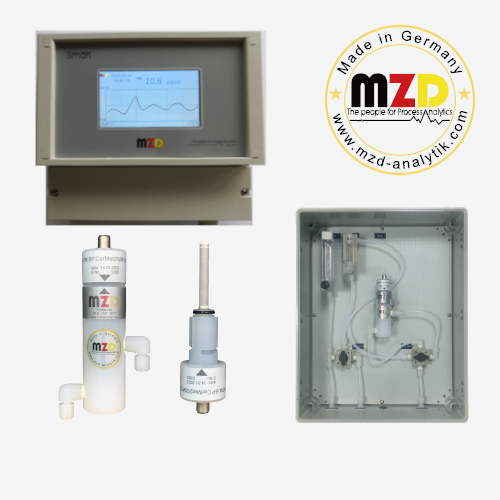
Application of SMART-MT Trace Moisture Analyzer in Fluorine Gas or Hydrogen Fluoride Gas
1. Overview of fluorochemicals
Fluorine chemical industry is a chemical industry using fluorite (CaF2) as the basic raw material. With its excellent performance of chemical resistance, high and low temperature resistance, aging resistance, low friction and insulation, fluorochemical products are widely used in various fields, such as chemical, electronic, pharmaceutical, biological and mechanical industries, and have become one of the fastest growing and most promising industries in the chemical industry.
Since the rise of fluorine chemical industry in the 1930s, it has been nearly ninety years of history. The product variety has been increasing and the application field has been expanding. So far, four major product series have been formed: inorganic fluoride, ODS (ozone depleting substances) and its substitutes, fluorine polymer and fluorine-containing fine chemicals. At present, there are more than a thousand kinds of fluorine chemicals in the world, with a total output of over 2 million tons and a sales market of tens of billions of dollars. With the progress of science and technology, new fluorine chemical products are constantly introduced, and the market demand for fluorine chemical products is increasing, so fluorine chemical industry has become a high-tech industry closely watched by the world.
2. fluorochemical process
2.1 Production method of anhydrous hydrogen fluoride
A lot of manufacturers use fluorite powder, concentrated sulfuric acid and fuming sulfuric acid as raw materials, which are heated in a rotary furnace to generate crude hydrogen fluoride gas, and then obtained anhydrous hydrogen fluoride products through washing, cooling, condensing, distillation and degassing, with silicon fluoride and fluorinated gypsum as by-products, and then use hydrogen fluoride as raw materials to synthesize other organic fluorides.
2.2 Industrial chain of fluorine chemical industry
3. Trace moisture analysis is mainly applied in the fluorine chemical industry
3.1 Production of fluorine gas
3.1.1 Fluorine gas production method
Fluorine gas is a very corrosive diatomic gas and highly toxic. Fluorine is the most electronegative element and a very strong oxidizer. At room temperature, it can be combined with almost all elements and generate a lot of heat energy, and among all elements, fluorine is the most active. Fluorine gas can be disproportionated with water: 2F2+2H2O=4HF+O2 .
3.1.1 Fluorine gas production methods
The industrial production method of fluorine gas is usually: electrolysis of a mixture of potassium hydrogen fluoride and hydrogen fluoride, with compacted graphite as the anode and steel electrolyzer body as the cathode, using potassium hydrogen fluoride as the electrolyte, electrolysis of anhydrous hydrofluoric acid, and then purification.
Total reaction formula of electrolysis: 2KHF2=2KF+H2↑+F2↑
3.1.2 Difficulties of fluorine gas production
Because fluorine gas is easy to react with water to release oxygen and hydrogen fluoride, and hydrogen fluoride is easily soluble in water, if the moisture content in fluorine gas is high, hydrofluoric acid will be generated, which will corrode the pressurized equipment in the pressurization process.
3.1.3 Difficulties to overcome
Daily production needs to sample and analyze the moisture content in the fluorine gas before pressurization to protect the pressurization equipment.
3.2 Lithium hexafluorophosphate electrolyte production (lithium battery industry)
Lithium hexafluorophosphate electrolyte is mainly used in lithium-ion battery manufacturing. It is a new generation of lithium-ion battery manufacturing materials, lithium hexafluorophosphate products with green, occupy a small volume, less heat, high energy storage, cost-effective and other significant features. Now it's mainly used in energy storage batteries, power batteries and digital, lighting series of lithium batteries and other products.
3.2.1 Lithium hexafluorophosphate electrolyte production method
Gas-solid reaction method: LiF is treated with anhydrous HF to form porous LiF, and then PF5 gas is passed into the reaction to obtain the product.
The main reaction is as follows: LiF(s) + HF(g) LHiF2(s) LiF(porous) + HF(g)
LiF(porous)+PF5 LiPF6
Solvent method: dissolve lithium fluoride in anhydrous hydrogen fluoride to form LiF, HF solution, pass high purity PF5 gas into the reaction, then cool the solution to below -20℃, lithium hexafluorophosphate crystallization precipitation, low temperature filtration and drying to get lithium hexafluorophosphate products.
At present, the mainstream production process of lithium hexafluorophosphate is to use anhydrous hydrogen fluoride solvent method to produce lithium hexafluorophosphate.
3.2.2 Difficulties in the production of lithium hexafluorophosphate electrolyte
The main technical bottleneck in the production of lithium hexafluorophosphate is the high requirement of anhydrous environment.
3.2.3 Difficulties to overcome
Online monitoring of the trace moisture of the inert protective gas to ensure that its moisture content is below 1ppm.
4. SMART-MT trace moisture analyzer features
High measurement accuracy, stable operation, long service life, moderate price and low maintenance cost. Ceramic sensor is resistant to HF, SO2 corrosion, low cost of use (no calibration required, regular regeneration of probe coating with 40% phosphoric acid).
